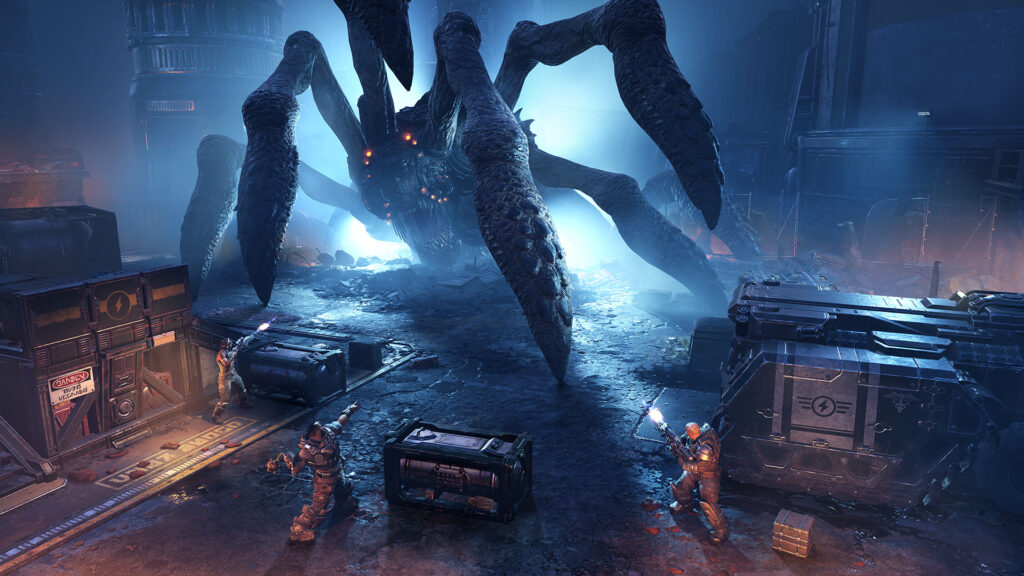
It’s not uncommon for long-running, high profile game franchises to get spin-offs that play with the formula in unique ways, or even swap genres altogether. In the worst case scenarios, you end up with a cynical cash-in chasing current trends, leading to long-time fans reciting a certain famous quote by Adam Jensen in Deus Ex: Human Revolution.
Occasionally, however, you’ll get a bizarre match that somehow manages to work. While Gears of War and XCOM both have a fetish for chest-high walls and cover-based shooting, the audiences these franchises usually court are extremely different.
When it was first announced, I remember seeing quite a few Gears of War fans scoffing at the idea of a turn-based entry in the franchise. Meanwhile, strategy fans were no doubt confused to see a shooter usually associated with dudebro culture dipping its toes into a more cerebral genre.
Regardless of how these two camps view the game’s concept, I’m glad whatever madman that concocted the idea of Gears Tactics was given the time and resources to see it realized.
Gears Tactics
Developers: Splash Damage, The Coalition
Publisher: Microsoft Game Studios
Platforms: Windows PC (Reviewed), Xbox One
Release Date: April 28th, 2020
Players: 1
Price: $59.99
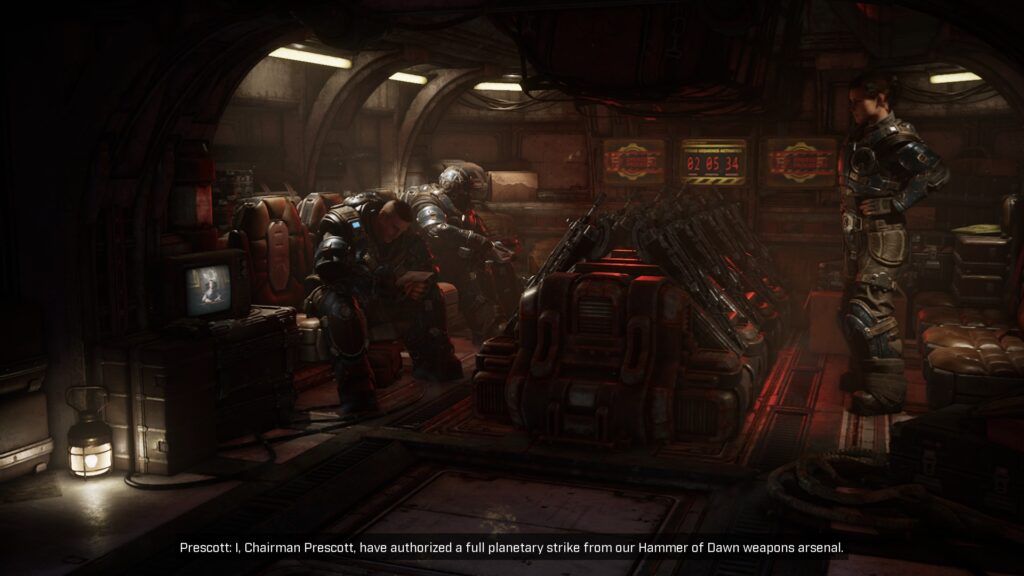
Gears Tactics is set shortly after Emergence Day, some 12 years before the original game. The game opens up mere hours before the infamous operation where the COG attempted to quickly end the war against the Locusts by using the Hammer of Dawn. Needless to say, the Hammer of Dawn strikes cause very little real damage to the Locusts.
In hindsight, maybe it didn’t really make sense to use orbital bombardments on the planet’s surface to try and deal a decisive blow to a race of subterranean monsters that move around with underground tunnels.
The game follows Gabriel Diaz, an ex-COG special forces operative that transferred to the motor pool after a botched mission during the Pendulum Wars. If that name sounds familiar, its because Gabe is the father of Kait Diaz, a major character in Gears of War 4, and the main protagonist of Gears of War 5.
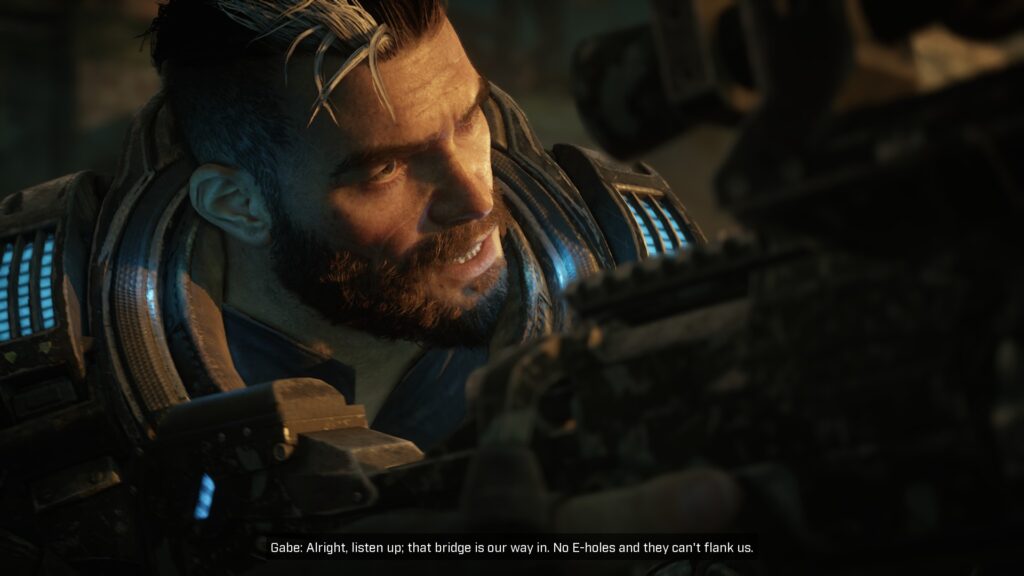
In fact, Gears Tactics is just as much a prequel to the new, post-Epic Games Gears of War series as it is to the original four games. The story introduces many characters and plotlines that would later become relevant in Gears 4 and 5, and also dips more into the origins of the Locust.
Gabe, still haunted by the missions he was forced to do during the Pendulum Wars, is reluctantly dragged back into action by Chairman Prescott. The COG is scattered and disorganized after E-Day and the subsequent Hammer of Dawn strikes, and Prescott assigns him a dangerous new mission: To find and assassinate Ukkon.
Ukkon is a Locust commander causing havoc across COG territory. More importantly, he is the geneticist responsible for many of the Locust’s biological war machines, including the Brumak and Corpser.
Together with Sid Redburn (a veteran Gear assigned to Gabe by Prescott), and Mikayla Dorn (a resistance leader that the duo rescued from a besieged convoy) Gabe will need to recruit an army from the scattered remnants of COG military personnel and civilian volunteers as they track Ukkon’s movements, and devise a plan to kill him.
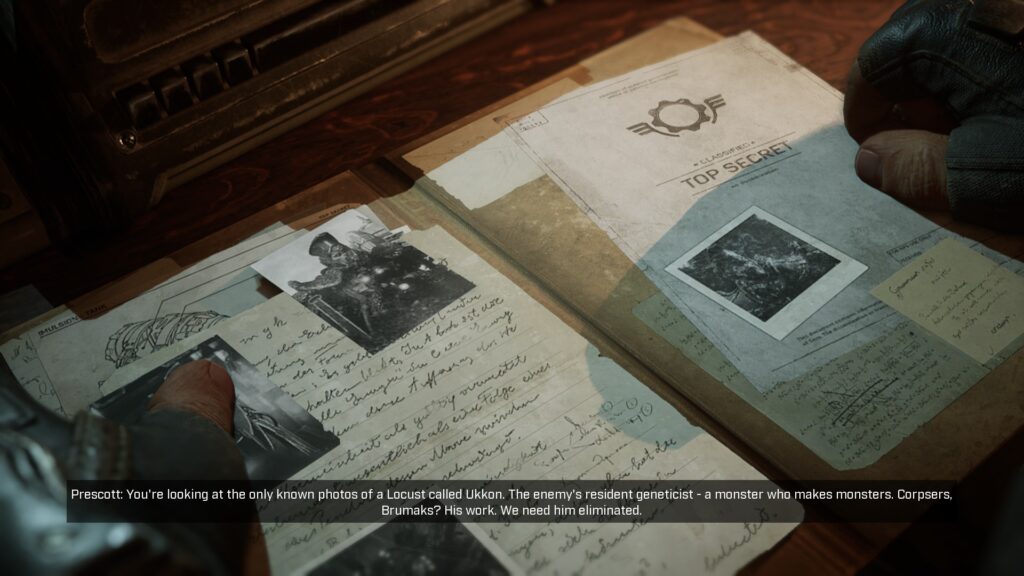
My first impressions of Gears Tactics were violently negative. Not because of the game itself, mind you, but because of Xbox Live. The game requires an Xbox Live account to even get to the main menu, and it had major issues with logging-in. A brief look at the Steam forums shows that I wasn’t the only one having issues like this. As infuriating as it was, luckily the game and Xbox Live have worked fine ever since.
One thing that XCOM fans will no doubt immediately be disappointed by is the lack of base management in Gears Tactics. This seems like a real missed opportunity as well, because in the story Gabe literally has a mobile outpost and convoy at his disposal. Prescott even makes it clear that Gabe is on his own, and won’t be receiving any support from the COG.
Given the circumstances, base and resource management seems like a no brainer for Gears Tactics. Instead, the only “upgrades” you get to your convoy is an increased recruitment cap at specific points throughout the campaign.
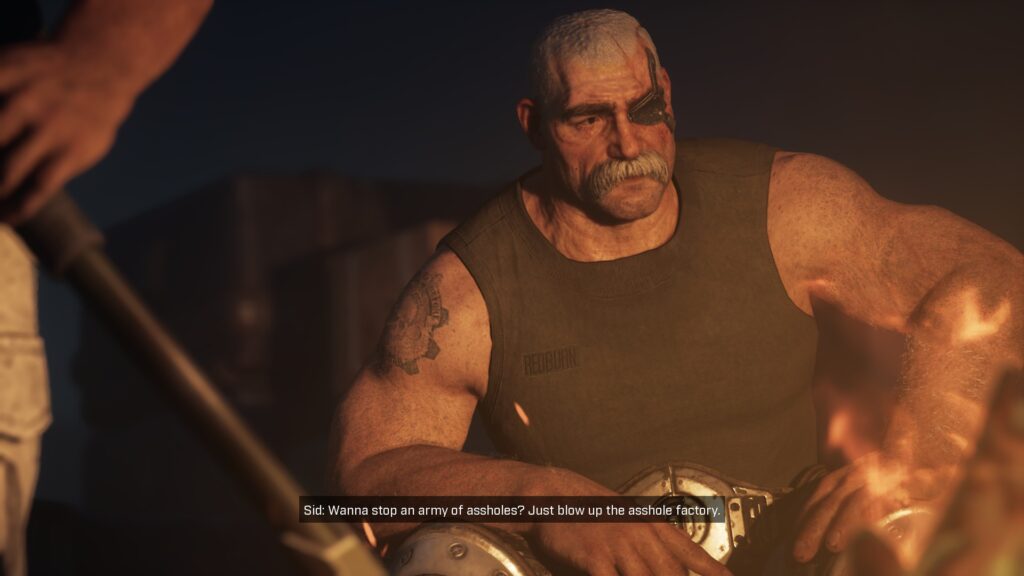
Instead, Gears Tactics leans on skill trees and loot drops as the basis of its progression system. There are five character classes in the game, each with their own skill trees. When a character levels up, they are given two skill points to buy new abilities. Each class tree branches into four core archetypes.
The Heavy, for example, can be geared to a more defensive archetype that focuses on hunkering down behind cover and unleashing withering barrages of bullets in overwatch; or a demolitionist role that is all about grenades, explosives, and reduced cooldowns for them.
In terms of the classes themselves, they cover most of the roles you’d expect from a game like this. The Support is a combat medic equipped with the franchise’s signature Lancer assault rifle. Alternatively, you can spec your Support out to focus more on buffing your squad, or giving out extra action points.
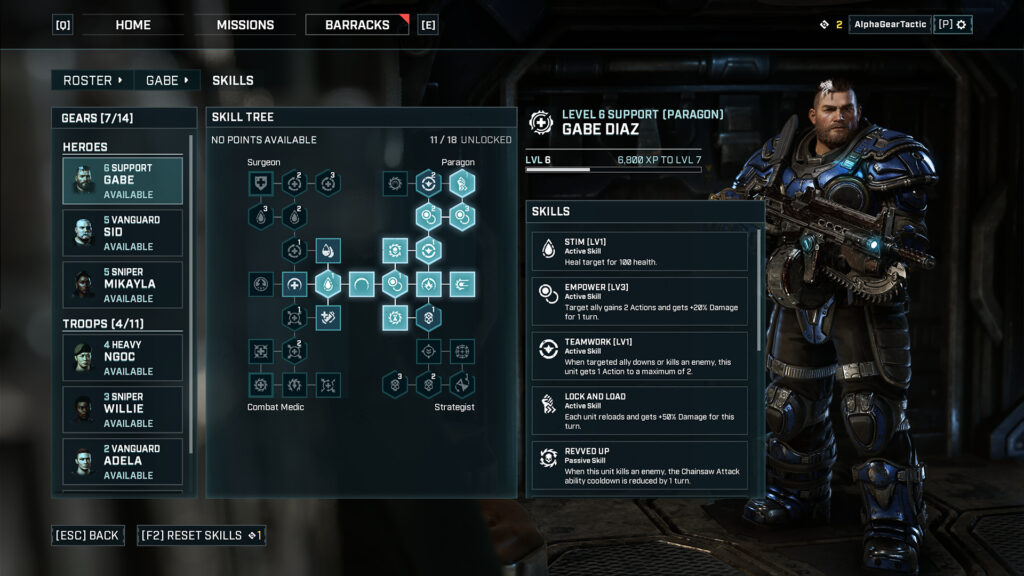
The aforementioned Heavy carries around the Mulcher Gatling gun introduced in the second game. They get bonuses for staying in the same position and effectively acting like a walking pillbox, but you can gear them towards a more mobile role as well.
The Vanguard is a frontline shock trooper with a Retro Lancer. Depending on how you build them, they can be tough, damage-soaking tanks, or terror troops that demoralize enemy forces.
The Sniper is pretty self-explanatory. You can focus on making them deliver consistently high damage single shots, or crank up their crit chances and crit damage to make their devastating headshots happen more often.
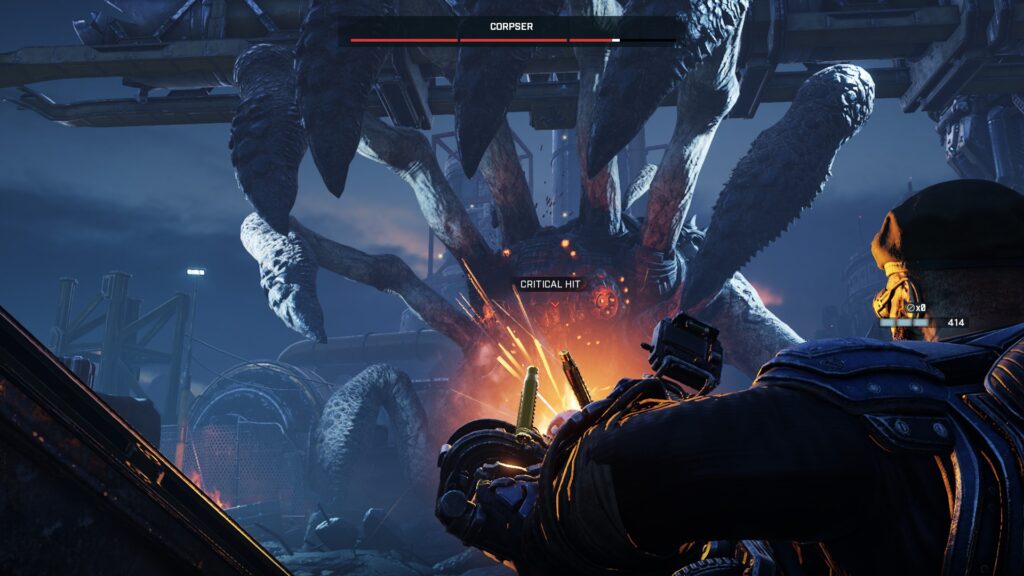
Finally, there is the shotgun-toting Scout. This highly mobile class is really effective at, surprisingly enough, scouting ahead of your squad. They can cloak, and depending on the skill tree you go down, they can focus more on traps like proximity mines, or clearing out groups of chaff at close range with multiple shotgun blasts per attack action.
Should you decide you don’t like a character’s build, there is a respec system. This consumes respec tokens that you are awarded throughout the campaign. While you get around a dozen respec tokens during the campaign, they are still a finite resource.
The loot system is the other half of character customization. You get one piece of loot for completing a mission, and can get a loot chest for grabbing the mission’s optional objective. Each mission also features three more loot chests scattered around the map.
These are normally in places that aren’t too far from the mission’s objectives, but are just enough out of the way that you’ll need to think about when, or even if, you’ll go for them. You shouldn’t have trouble getting all three in most missions, but every now and then you may have to miss one due to time constraints.
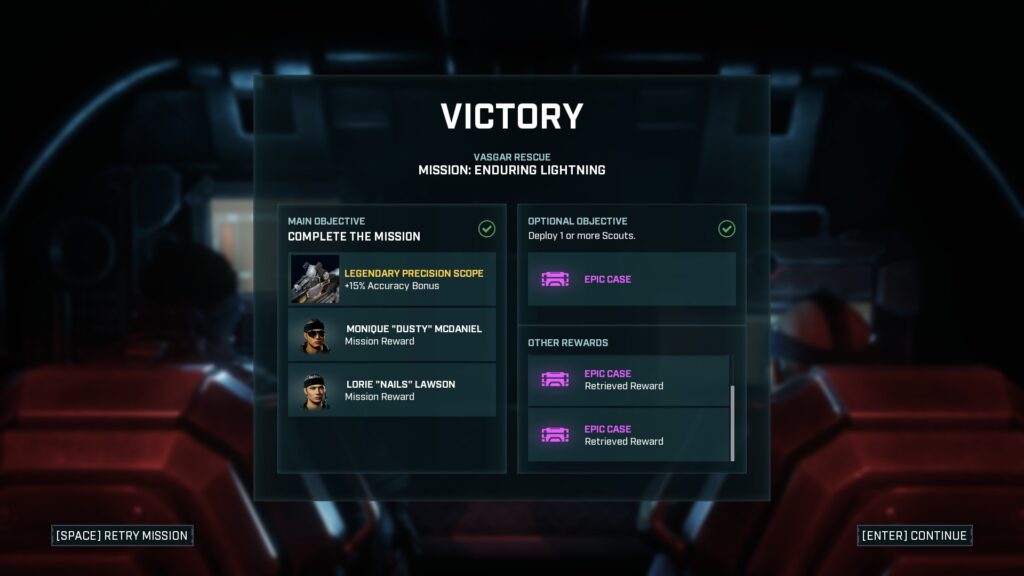
I use the term “loot crate,” but in a shocking display of restraint for the AAA games industry in 2020, Gears Tactics features no actual microtransactions. You have to earn your loot chests by grabbing them in missions, and completing optional objectives.
The loot in the game conforms to the usual Common, Rare, Epic, and Legendary rarity system you’ve all come to expect from a video game. The common and most of the rare drops are pretty boring, but some of the epics and legendaries can alter how you play a character.
There are lots of “+5% accuracy” or “+20% more effective healing” in the loot system, but there are also many pieces of gear that add interesting keywords and proc effects. For example, a piece of gear might grant Blitz, which gives a character a 40% chance to generate an extra action point if they didn’t shoot in the last turn, or a 60% chance to reduce a skill’s cooldown at the beginning of your turn.
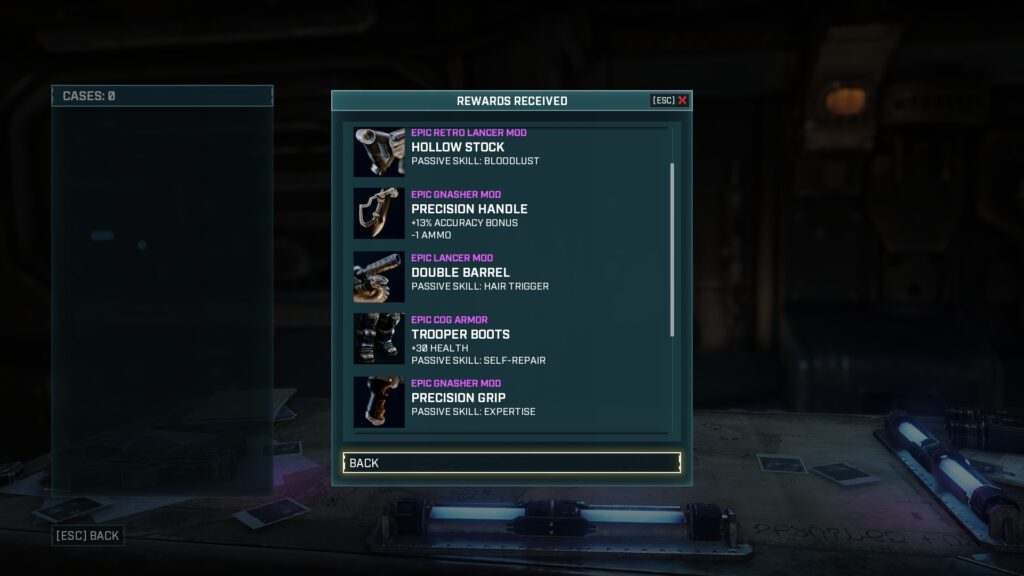
While you can’t swap out a character’s actual weapons, each primary gun has four loot slots. These are typically things like the barrel, stock, magazine, sights, etc. There is even a degree of visual customization as you swap out parts on a gun. You can also find rare snub pistols or grenades, but there isn’t any individual part customization for your sidearms.
Besides weapons, characters can also have a helmet (which can be hidden if you want the bonuses without a character’s head being covered), chest armor, and leg armor.
The loot system, when combined with the skill trees, can create some ridiculously overpowered characters as the campaign drags on. If you love min-maxing and tweaking builds to create complicated synergies, then you’ll find a lot to enjoy in Gears Tactics.
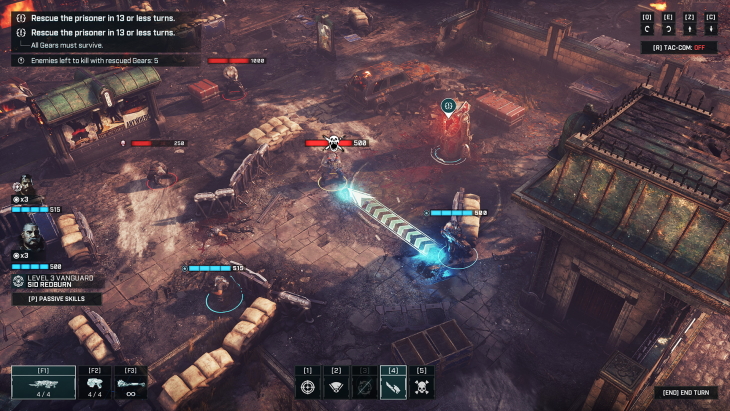
While it’s true that all five classes effectively boil down to “kills things in ____ way,” there is still a lot to like here. You might not be able to significantly alter the way a class plays, but you can tweak them enough and create synergies that are satisfying to use.
Loot management, on the other hand, could definitely be improved in places. The game’s UI was clearly designed with consoles in mind, meaning that as the game progresses and your inventory gets full, scrolling through all the loot you’ve acquired to compare with what your characters have equipped can get tedious.
Since there is no base management or economy, then there is also nothing to actually do with excess loot besides just deleting it from your inventory. Telling a gamer to just throw away excess loot is not a good idea. I want something in exchange for the loot dammit, don’t make me just throw away all these extra Lancer barrels and pants in my inventory!
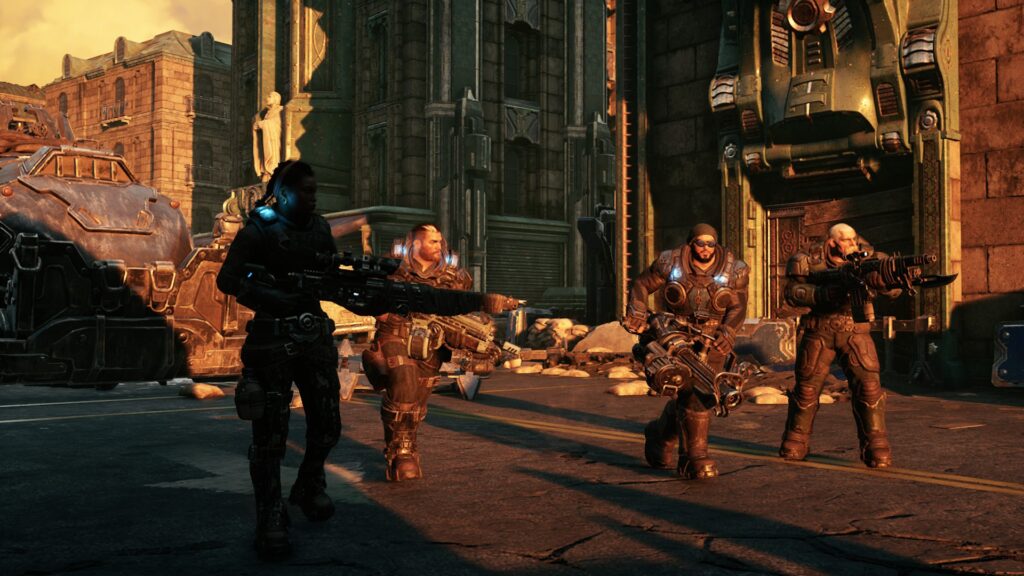
Characters themselves come in two types: Heroes and Troops. The Heroes are story relevant characters like Gabe, Sid, and Mikayla. They are often required for specific missions, and should they die, you’ll have to start the mission over again. Troops, on the other hand, are grunts that can die permanently.
You get new Troops from rescue missions, or can recruit them between levels. You will always have a rotating selection of three procedurally generated Troops available to recruit at any given time.
While you can’t customize their face, gender, or class, you can rename them and apply lots of cosmetics. These include hairstyles and colors, tattoos, scars, and various accessories like piercings, glasses, hats, facemasks, and so on. You unlock more cosmetics as the game progresses.
Regardless of if they are a Hero or a Troop, you can also change the colors, finishes, and patterns of a character’s armor and weapons. The character customization is fairly decent, even if you can’t really change faces, genders, or ethnicity.
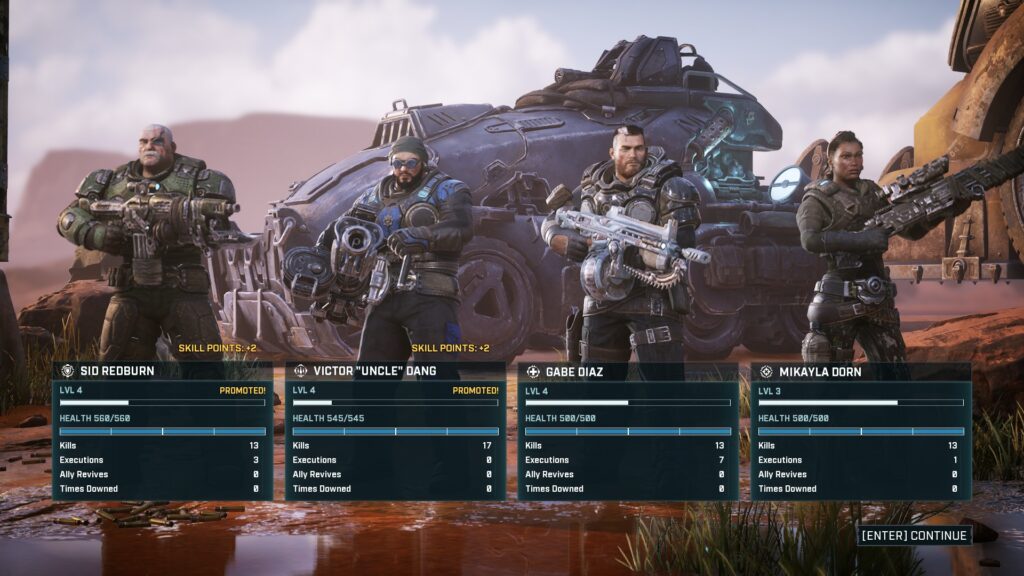
Character progression overall is pretty solid, I think the game could be a tad more generous with experience. Leveling up can take quite a while, and since the level of your potential recruits scales with the story, its entirely possible that fresh recruits might be a higher level than a character you’ve had for a while.
While there is a ton of character customization, skill building, and min-maxing, the combat is where Gears Tactics excels. The game is a moderately straightforward XCOM clone, but exceptionally well polished and designed.
Outside of specific mission limitations, you’ll bring a squad of four Gears to each level. Each Gear has, by default, three action points to play with per turn. These can be used to move, shoot, setup overwatch, reload, use a cooldown-based special skill, and so on.
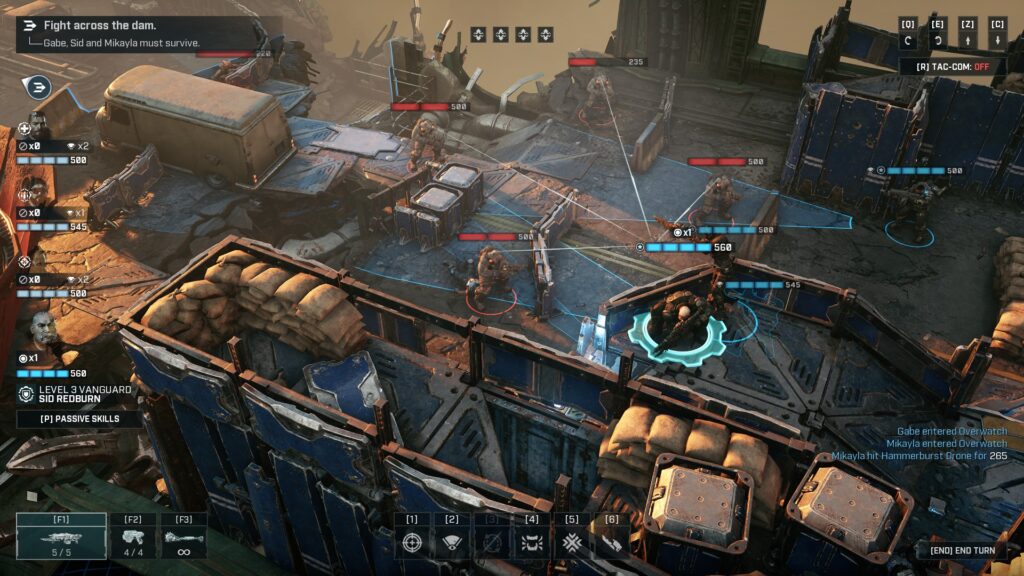
The overwatch system in Gears Tactics works a bit differently than most games in the genre. Instead of becoming an all-seeing turret, when a character goes into overwatch they place down a narrow cone of fire. When something enters that cone, they’ll shoot at it. The number of times a character will fire during overwatch is based on how much AP they had left when you clicked the overwatch key.
Despite being a turn-based tactics game, Gears Tactics completely nails the look and feel of the Gears franchise. Many mechanics from the franchise are faithfully recreated here, including using grenades to destroy e-holes, picking up special weapons with limited ammunition like Torque Bows or Boomshots from fallen enemies, reviving downed squad mates, and even executing your foes.
Executing isn’t just a cool and gory cutscene of a curb stomp or bayonet shank, but a gameplay mechanic to base your moment-to-moment tactics around. When you execute a downed enemy, your characters get an extra AP, so its well worth trying to pull off whenever you get a chance.
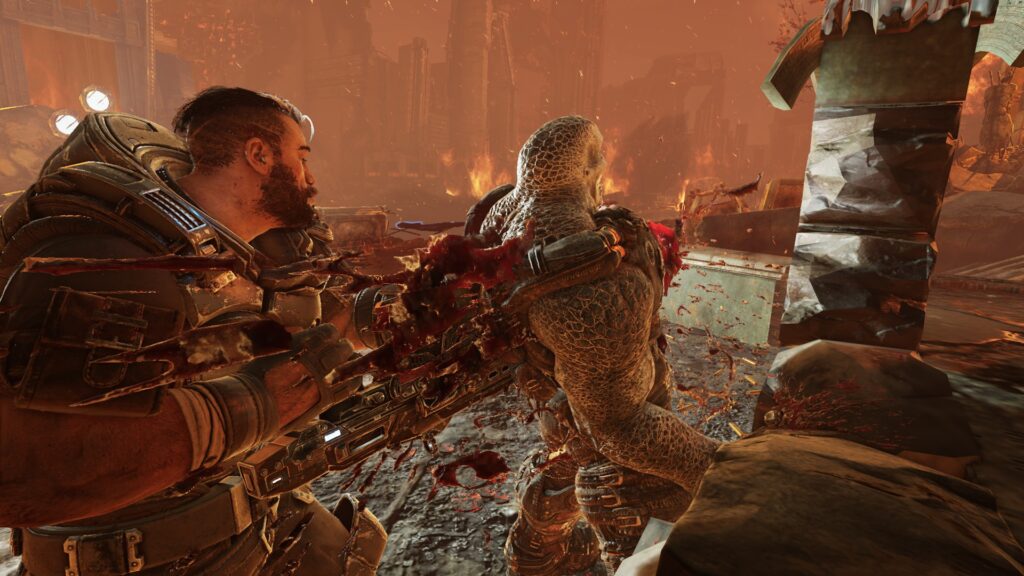
Gears Tactics also faithfully recreates the tactics and fighting styles of many of the franchise’s classic enemies. If you’ve played the original Gears games, then you’ll already have a good idea of how to counter most of the returning enemies. There’s also a few interesting new foes in the game, courtesy of Ukkon’s mad experiments.
Speaking of enemies, you will be fighting a lot of them at a time. One of the game’s marketing gimmicks is the number of enemies in each encounter, and they weren’t joking. When you face Tickers or Wretches, they are often in swarms of 8 or 10 at a time. The Locust regularly call in reinforcements, either from e-holes, or airdropped in by a Reaver.
You always start encounters greatly outnumbered, leading to some rather challenging engagements. Sometimes the adds can get a bit tedious, and this is exemplified in boss fights. Its not that the reinforcements make the boss fights too difficult. Rather, its just that when combined with the gigantic health pool of the bosses, the reinforcements can make these encounters drag on a bit too long.
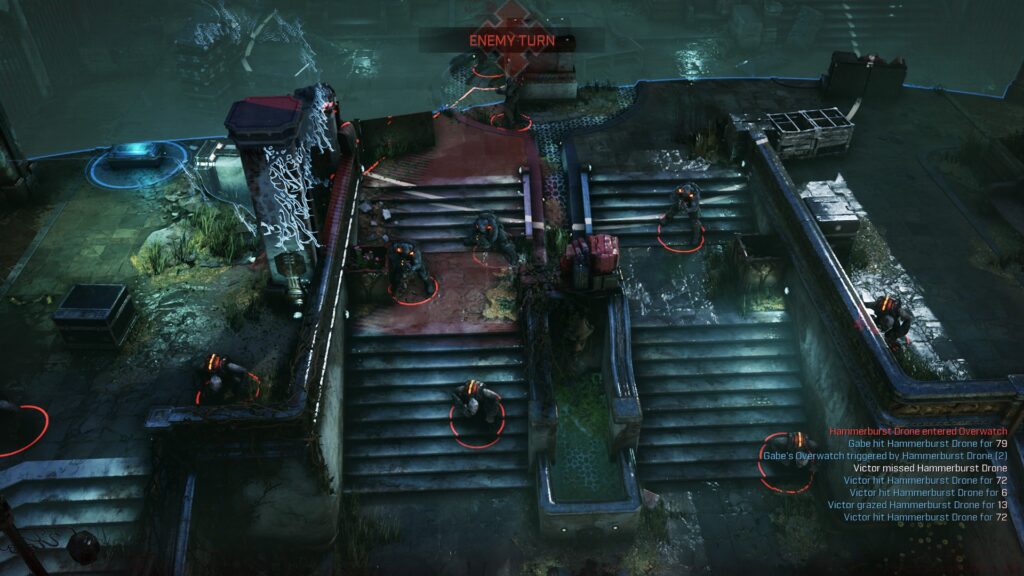
On the standard difficulty setting, Gears Tactics can get a bit challenging, but never overwhelmingly so. If things go south, you always have the option to restart the mission and try again. Those of you looking for a serious challenge will be happy to know that there is an Ironman setting, and two hard difficulties.
Ultimately, the biggest problem with the game’s combat is the lack of mission variety. While the story missions tend to have varied objectives and scripted events, the side missions are very limited.
The overall formula of the campaign typically involves a story mission or two, followed by some side missions that are great for improving your characters by grabbing some extra XP and loot. When you get to a side mission chapter, you are generally given a choice between three or four missions, and must complete two or three of them before moving on to the next story mission.
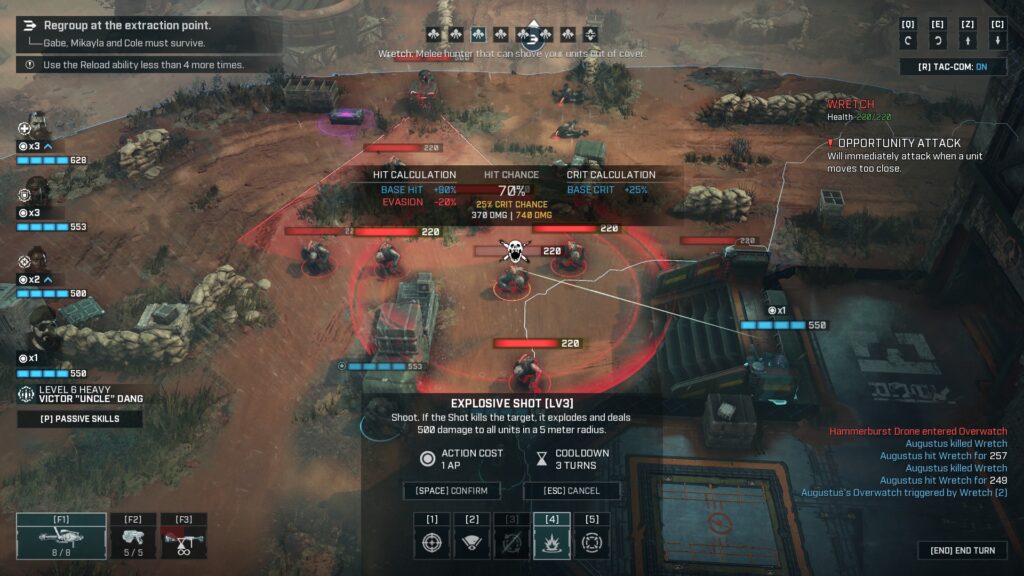
These missions technically take place simultaneously, so you can only send each character on a side mission once during that chapter. This is an interesting idea, and gives you a nice chance to level up new recruits to fill out your combat roster.
The issue is that there are only four mission types. You have a domination-style side mission where you need to hold two zones to gather points, as well as a loot crate grab and dash where you are picking up chests while being following by a creeping bombardment of Nemacysts.
There are also prisoner rescues where you have to liberate two Gears captured by the Locust, and a simple “kill all the enemies guarding the important thing” raid.
Since you’ll need to do side missions every one or two story missions, this formula gets old pretty fast. Worse yet is that sometimes these objectives pop up in main story missions, but at least in these cases there is usually an interesting scripted event to break things up.
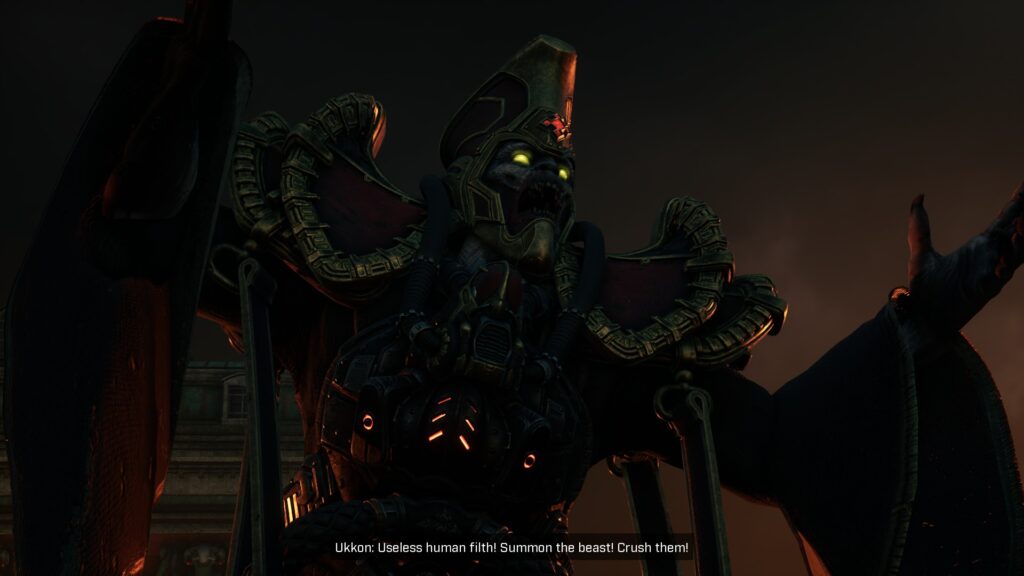
The modifiers for many of these side missions also feel really lame and “gamey.” Why can I only take two characters on this supply run side mission? Why can’t I use grenades on this side mission? The answer is that its supposed to make the mission more challenging, but they feel very arbitrary and remind you that you are playing a video game.
As I said earlier, Gears Tactics nails the look, feel, and sound of a Gears of War game. The visuals aren’t quite on the same level as the newer Gears of War titles, but they are still pretty damn impressive.
Enemies get cut into pieces by the franchise’s signature Lancer chainsaw, giblets fly everywhere when you throw a grenade into a group of enemies, and a Sniper’s critical hit animation tends to lead to exploding heads.
The audio and soundtrack are straight out of a Gears of War game, too. All the weapons have the sound effects you’d expect, and headshots or curb stomps have that same meaty explosion sound fans of the franchise will have come to expect.

In terms of performance on PC, the game is fantastic. There are tons of options to tweak, and even on my older system I was able to play with everything cranked up to ultra with only the occasional framedrop below 60.
That said, the game isn’t perfect from a technical standpoint. The texture pop-ins and other issues you come to expect from an Unreal Engine game are all present and accounted for.
The animations also glitch out every now and then, with the occasional neck snap execution move showing a character cradling the air as they dislocate a Grub’s spine. These issues aren’t super common, but they definitely happen.
The last complaint I have with the game is the preorder DLC. In case you didn’t hear, you could unlock Cole by preordering the game. He is a Vanguard class Hero that comes with some unique Thrashball-themed equipment. Preordering the game is the only way to get Cole, and I think that holding a fan favorite character like that for ransom is a bit scummy.

Sure, he doesn’t actually contribute anything to the story, and he functionally plays like any other Vanguard, but he is still fully voice acted and makes unique quips during combat. I just really don’t like the idea that an iconic character was made an exclusive bonus for preordering the game.
Gears Tactics is one of those rare examples of a spinoff we never asked for, simply because we didn’t realize we wanted it. Its not only a good Gears of War game, but a really solid XCOM clone. With greater mission variety, a bit more depth to character progression, and a base management system, this spinoff series could actually become a major competitor in the genre.
That’s something I really didn’t expect to say, either. If you would have told me four years ago that one of my favorite games in 2020 would be a Gears of War themed XCOM clone, I would have assumed you were a raving lunatic.
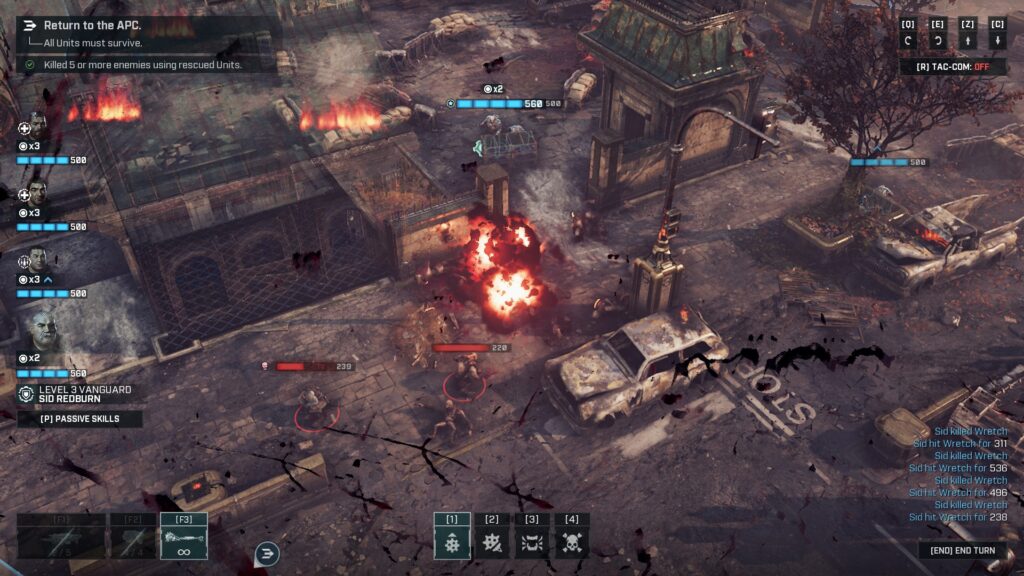
Even with all its faults, Gears Tactics kept me entertained for the full 30 or so hours it took me to finish the campaign. Hopefully, the developers take the issues I and many others have brought up to heart, and deliver an excellent sequel a few years down the road.
Some Images: Steam
Gears Tactics was reviewed on Windows PC using a personal copy. You can find additional information about Niche Gamer’s review/ethics policy here.